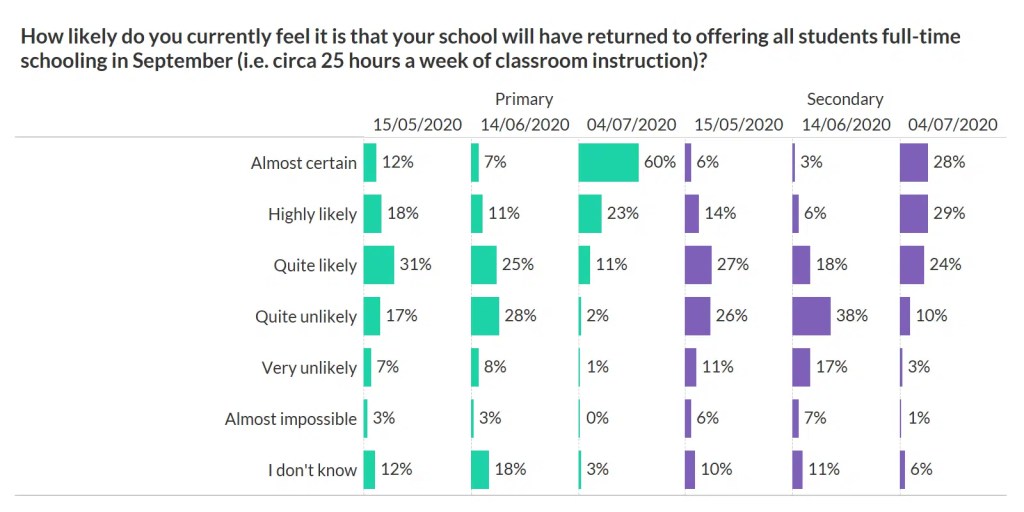1. Daily life is changing
Among all the zaniness of daily school life, we could nevertheless assume in the past that, on any given day, the vast majority of teachers were in a school building, delivering planned lessons in a classroom and taking part in a bunch of duties, meetings and marking/data tasks. These days, we can’t!
Now, over 70% of primary teachers are working in a school, but only about a third of secondary teachers are. Of those secondary teachers in school, many are conducting student tutorials rather than class teaching. And for those of you teaching from home, the picture is even more varied!

Last Tuesday, 17% of teachers in state-secondary schools hosted a live online lesson where students could talk; 6% hosted an online lesson without students speaking; and 24% pre-recorded a video for students to watch in their own time. All these figures are much higher than in late April and early May – despite a third of teachers now being in school.
The graph below shows the changes over time with some quite dramatic shifts. For example, at the end of April just 6% of state secondary teachers were running live online lessons. It is now 17% – almost three times as many. (Somewhat proving the point that schools really needed time to set these things up!)

2. Would you encourage your own child to teach?
Many teachers had a parent who was a teacher – but would they encourage their own child to follow the pattern? We periodically ask this question as it helps us assess changes in how you feel the profession is treated and whether it is a worthwhile job route.
The good news is that COVID-19 hasn’t changed your responses – 44% of you would encourage your own child to become a teacher and only 9% would actively counsel against it. These figures are very similar to this time last year.
The only slight worry is that those most likely to have children in their twenties, and therefore more likely to enter the profession, are in their 40s and 50s, and these ages are the most likely to express reservations!

3. Relaxing during the pandemic
Has the COVID-19 pandemic changed how you choose to wind down after a stressful day? Yes, a little.
Back in January we asked how you would react after a challenging day. Last week, we asked again. You are now more likely to take some physical exercise (45% versus 34%), talk to a friend (45% versus 33%) or drink alcohol (47% versus 33%).

But look again at that graph. Almost every category of self-care has increased except for… work! Given the substantial gains in the other items, it’s intriguing that work has fallen so far down. What might account for this? (Could it be that work is causing fewer of the issues these days?)
Another notable shift is that book-reading was previously the third most popular category while it now languishes in 7th place. Have we become more excited by exercise and chatting to our friends because of lockdown? (Or is it simply related to the weather?) The only way for us to find out is to keep asking!
4. We’re NOT going on a summer holiday?!
Teachers are a captive market for travel companies. Unable to holiday outside of term-time they make up a large number of those who travel abroad during the lucrative summer season. How badly has Covid-19 interrupted this year’s travels? Comparing your summer plans to the previous two years: a lot.
This year just 7% of you have planned to go abroad for a week or less, and a further 7% for 8 to 14 nights. Just 3% are planning a more extended trip. In normal years these figures are closer to 20%, 20% and 10% – suggesting that around 2/3rds of trips have been cancelled this year.

5. What will happen in September?
Despite the disrupted summer plans, teachers are increasingly certain that school will be back to full-time instruction for all pupils from September. The leap in certainty occurred after the government’s announcement that all kids back in all schools for all subjects is the new plan. (Though note that certainty is not always linear – it fell in June before bouncing back up).

The schools that our children return to may not look the same, however. Not only will there be social distancing measures but the majority of teachers have said that some parts of their teaching practice will change too.
The graphs below show the extent to which teachers agree (green) or disagreed (purples) that they would now change either their (a) assessment, (b) homeworks, or (c) classroom practice, because of what they learned during lockdown.

Homework is the area most likely to change – with 66% of primary teachers and 78% of secondary teachers saying they would do something differently in future. Things we’ve seen on social media include using voice notes for giving feedback (rather than written work) and using online apps/quizzing rather than collecting in work on paper.





